Comparative Analysis: Carlsberg and Heineken's Transaction Exposure
VerifiedAdded on 2020/05/16
|10
|2501
|59
Report
AI Summary
This report provides a comparative analysis of the foreign currency transaction exposure faced by Carlsberg and Heineken, two major players in the international brewing industry. It examines the various risks these companies encounter, including foreign exchange rate fluctuations, interest rate fluctuations, raw material price risk, and credit risk. The report details the specific exposures of each company, highlighting the differences and similarities in their situations. Furthermore, it explores the tools and strategies employed by Carlsberg and Heineken to manage these exposures, such as foreign exchange contracts, cross-currency interest rate swaps, and commodity swaps. The conclusion emphasizes the importance of hedging contracts for companies operating internationally to mitigate financial losses from currency movements. The report references financial data from 2015 and 2016 to support its analysis, offering insights into the practical application of international finance principles within the context of these global businesses. The report is a comparative analysis of two major international brewing companies and the challenges they face in the global market.
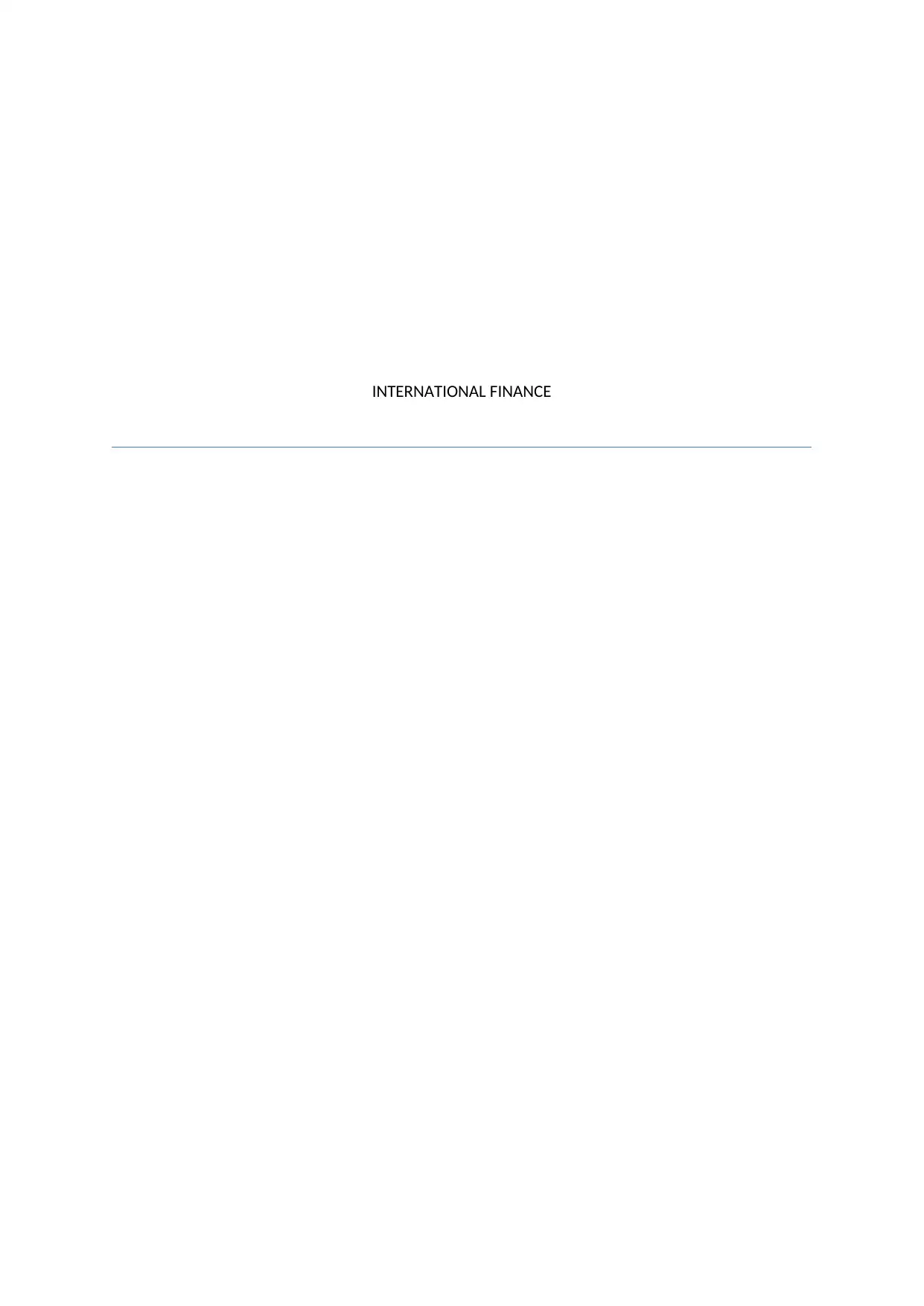
INTERNATIONAL FINANCE
Paraphrase This Document
Need a fresh take? Get an instant paraphrase of this document with our AI Paraphraser
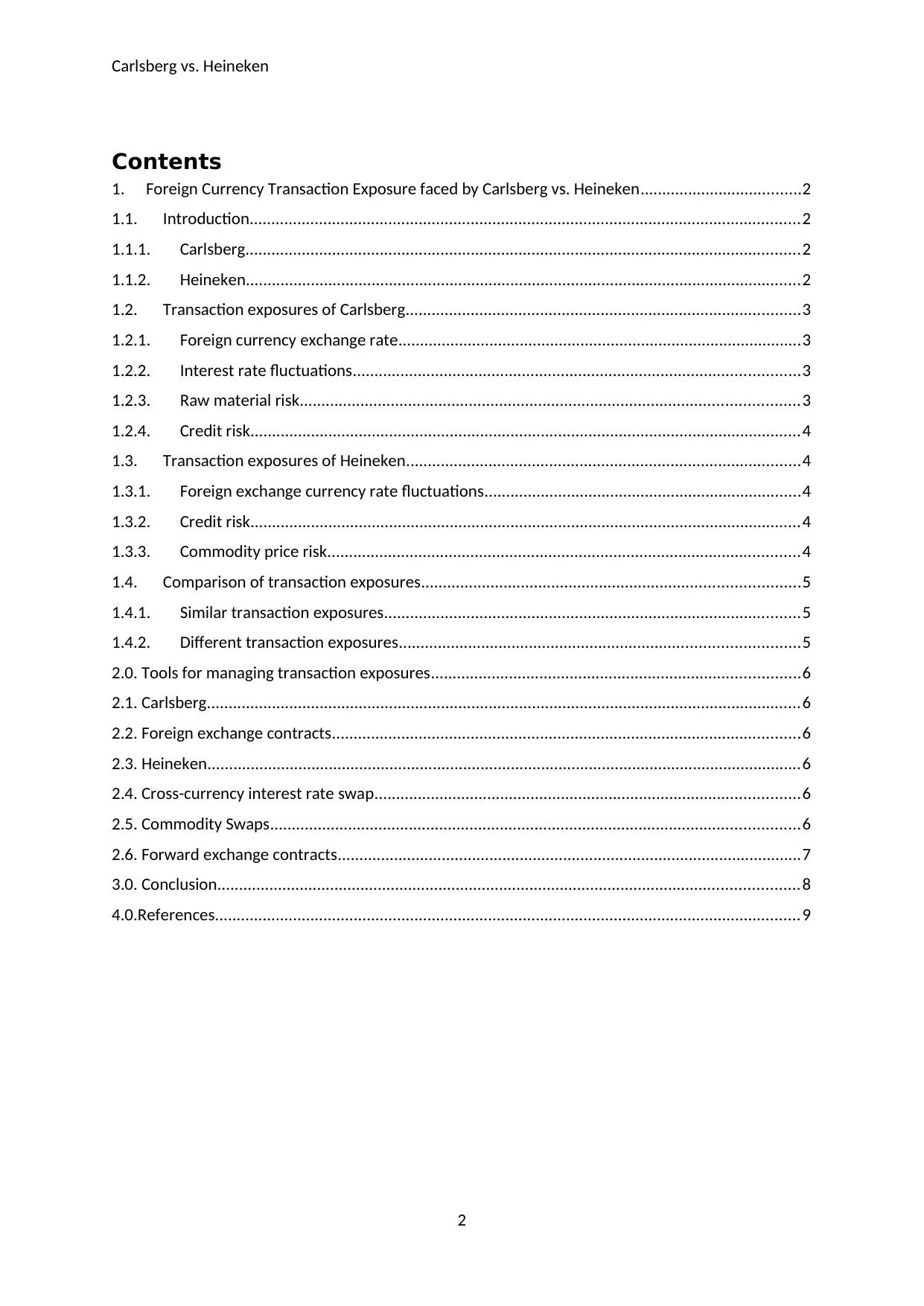
Carlsberg vs. Heineken
Contents
1. Foreign Currency Transaction Exposure faced by Carlsberg vs. Heineken.....................................2
1.1. Introduction...............................................................................................................................2
1.1.1. Carlsberg................................................................................................................................2
1.1.2. Heineken................................................................................................................................2
1.2. Transaction exposures of Carlsberg...........................................................................................3
1.2.1. Foreign currency exchange rate.............................................................................................3
1.2.2. Interest rate fluctuations.......................................................................................................3
1.2.3. Raw material risk...................................................................................................................3
1.2.4. Credit risk...............................................................................................................................4
1.3. Transaction exposures of Heineken...........................................................................................4
1.3.1. Foreign exchange currency rate fluctuations.........................................................................4
1.3.2. Credit risk...............................................................................................................................4
1.3.3. Commodity price risk.............................................................................................................4
1.4. Comparison of transaction exposures.......................................................................................5
1.4.1. Similar transaction exposures................................................................................................5
1.4.2. Different transaction exposures............................................................................................5
2.0. Tools for managing transaction exposures.....................................................................................6
2.1. Carlsberg.........................................................................................................................................6
2.2. Foreign exchange contracts............................................................................................................6
2.3. Heineken.........................................................................................................................................6
2.4. Cross-currency interest rate swap..................................................................................................6
2.5. Commodity Swaps..........................................................................................................................6
2.6. Forward exchange contracts...........................................................................................................7
3.0. Conclusion......................................................................................................................................8
4.0.References.......................................................................................................................................9
2
Contents
1. Foreign Currency Transaction Exposure faced by Carlsberg vs. Heineken.....................................2
1.1. Introduction...............................................................................................................................2
1.1.1. Carlsberg................................................................................................................................2
1.1.2. Heineken................................................................................................................................2
1.2. Transaction exposures of Carlsberg...........................................................................................3
1.2.1. Foreign currency exchange rate.............................................................................................3
1.2.2. Interest rate fluctuations.......................................................................................................3
1.2.3. Raw material risk...................................................................................................................3
1.2.4. Credit risk...............................................................................................................................4
1.3. Transaction exposures of Heineken...........................................................................................4
1.3.1. Foreign exchange currency rate fluctuations.........................................................................4
1.3.2. Credit risk...............................................................................................................................4
1.3.3. Commodity price risk.............................................................................................................4
1.4. Comparison of transaction exposures.......................................................................................5
1.4.1. Similar transaction exposures................................................................................................5
1.4.2. Different transaction exposures............................................................................................5
2.0. Tools for managing transaction exposures.....................................................................................6
2.1. Carlsberg.........................................................................................................................................6
2.2. Foreign exchange contracts............................................................................................................6
2.3. Heineken.........................................................................................................................................6
2.4. Cross-currency interest rate swap..................................................................................................6
2.5. Commodity Swaps..........................................................................................................................6
2.6. Forward exchange contracts...........................................................................................................7
3.0. Conclusion......................................................................................................................................8
4.0.References.......................................................................................................................................9
2
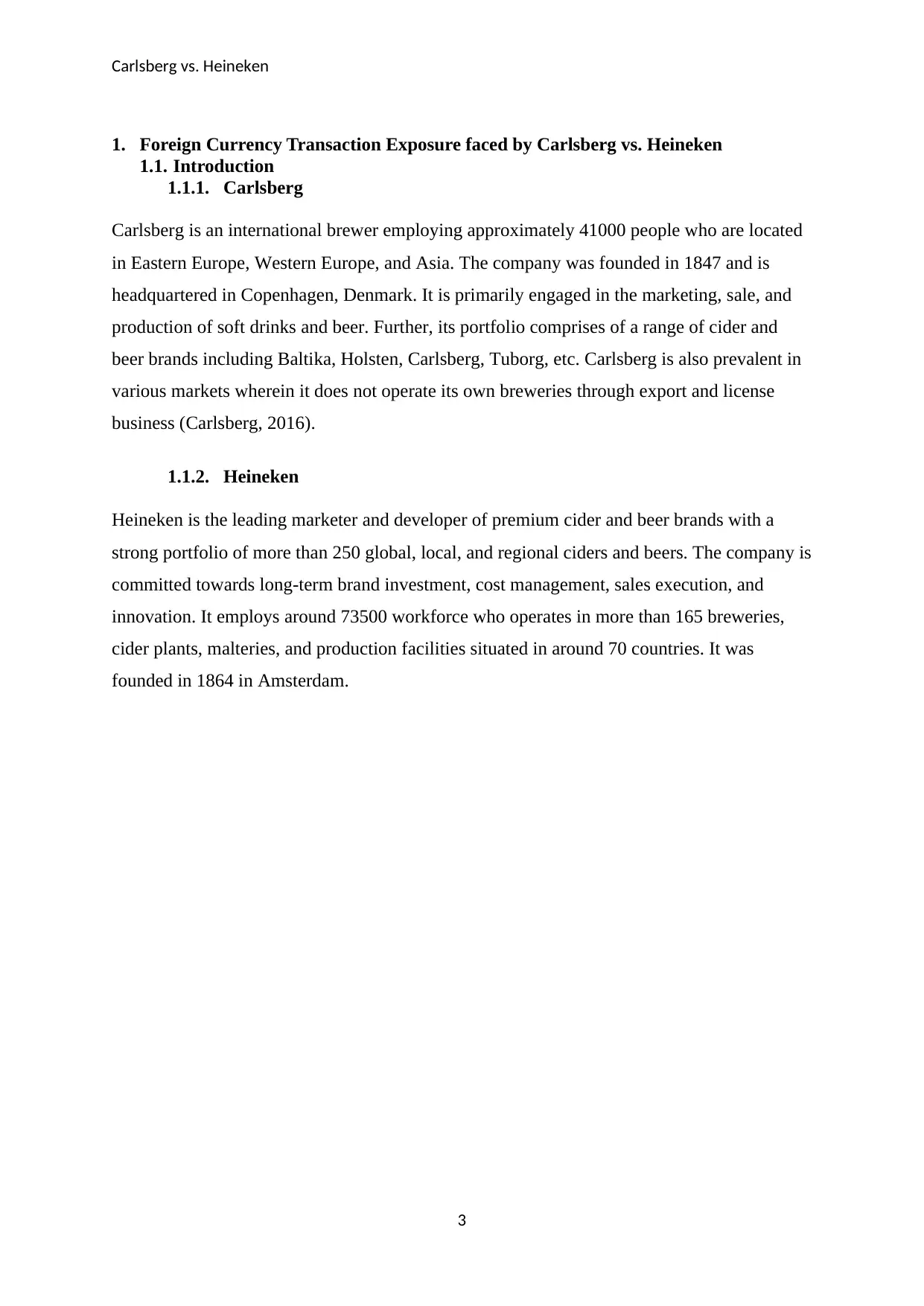
Carlsberg vs. Heineken
1. Foreign Currency Transaction Exposure faced by Carlsberg vs. Heineken
1.1. Introduction
1.1.1. Carlsberg
Carlsberg is an international brewer employing approximately 41000 people who are located
in Eastern Europe, Western Europe, and Asia. The company was founded in 1847 and is
headquartered in Copenhagen, Denmark. It is primarily engaged in the marketing, sale, and
production of soft drinks and beer. Further, its portfolio comprises of a range of cider and
beer brands including Baltika, Holsten, Carlsberg, Tuborg, etc. Carlsberg is also prevalent in
various markets wherein it does not operate its own breweries through export and license
business (Carlsberg, 2016).
1.1.2. Heineken
Heineken is the leading marketer and developer of premium cider and beer brands with a
strong portfolio of more than 250 global, local, and regional ciders and beers. The company is
committed towards long-term brand investment, cost management, sales execution, and
innovation. It employs around 73500 workforce who operates in more than 165 breweries,
cider plants, malteries, and production facilities situated in around 70 countries. It was
founded in 1864 in Amsterdam.
3
1. Foreign Currency Transaction Exposure faced by Carlsberg vs. Heineken
1.1. Introduction
1.1.1. Carlsberg
Carlsberg is an international brewer employing approximately 41000 people who are located
in Eastern Europe, Western Europe, and Asia. The company was founded in 1847 and is
headquartered in Copenhagen, Denmark. It is primarily engaged in the marketing, sale, and
production of soft drinks and beer. Further, its portfolio comprises of a range of cider and
beer brands including Baltika, Holsten, Carlsberg, Tuborg, etc. Carlsberg is also prevalent in
various markets wherein it does not operate its own breweries through export and license
business (Carlsberg, 2016).
1.1.2. Heineken
Heineken is the leading marketer and developer of premium cider and beer brands with a
strong portfolio of more than 250 global, local, and regional ciders and beers. The company is
committed towards long-term brand investment, cost management, sales execution, and
innovation. It employs around 73500 workforce who operates in more than 165 breweries,
cider plants, malteries, and production facilities situated in around 70 countries. It was
founded in 1864 in Amsterdam.
3
⊘ This is a preview!⊘
Do you want full access?
Subscribe today to unlock all pages.

Trusted by 1+ million students worldwide

Carlsberg vs. Heineken
1.2. Transaction exposures of Carlsberg
Carlsberg foreign exchange transaction exposures are mainly derived from foreign currency
exchange rate fluctuations, interest rate fluctuations, raw material risk, and credit risk.
1.2.1. Foreign currency exchange rate
Carlsberg is exposed to transaction risks on sales and purchases in currencies instead of
functional currency of domestic entities. Besides, a significant portion of the Group’s affairs
take place outside Denmark and not in DKK currencies. Hence, foreign exchange risk can be
considered a major transaction exposure for the Group and as a result, fluctuations in the
exchange rate can possess a material impact on its financial statement (Jacque, 2010). This is
the reason why Carlsberg intends to hedge 70-90% of future cash flows in currencies on a 12-
month rolling basis (other than the functional currencies).
1.2.2. Interest rate fluctuations
The most relevant interest rate transaction exposure in the company relates to borrowings.
Since the entire debt of Carlsberg is in DKK and EUR, the exposures of interest rate relate to
development in interest rates in both currencies. Such interest rate risk is measured by the
time period of net financial debt (Carlsberg, 2016). Besides, in order to avoid foreign
exchange risk, the interest rate on borrowings must be in local currency but in case of
Carlsberg, the interest rate level in domestic currency and the additional cost of financing in
domestic currency is extremely high, thereby resulting into a foreign exchange risk (Pochon
& Jerome, 2011).
The net interest paid by Carlsberg amounted to DKK 1003 million in comparison to DKK
1818 million paid in 2015. Such decline was because of lower interest-bearing debts.
1.2.3. Raw material risk
The company also encounters foreign exchange transaction exposure due to the purchase of
malt, cans, and energy. Moreover, since the underlying market for specified categories of
packaging and raw materials vary, transaction exposure is more likely to occur (Carlsberg,
2016).
The cost of finished goods of the company enhanced by 11% because of such currency
impact from the appreciation of the Russian rouble.
4
1.2. Transaction exposures of Carlsberg
Carlsberg foreign exchange transaction exposures are mainly derived from foreign currency
exchange rate fluctuations, interest rate fluctuations, raw material risk, and credit risk.
1.2.1. Foreign currency exchange rate
Carlsberg is exposed to transaction risks on sales and purchases in currencies instead of
functional currency of domestic entities. Besides, a significant portion of the Group’s affairs
take place outside Denmark and not in DKK currencies. Hence, foreign exchange risk can be
considered a major transaction exposure for the Group and as a result, fluctuations in the
exchange rate can possess a material impact on its financial statement (Jacque, 2010). This is
the reason why Carlsberg intends to hedge 70-90% of future cash flows in currencies on a 12-
month rolling basis (other than the functional currencies).
1.2.2. Interest rate fluctuations
The most relevant interest rate transaction exposure in the company relates to borrowings.
Since the entire debt of Carlsberg is in DKK and EUR, the exposures of interest rate relate to
development in interest rates in both currencies. Such interest rate risk is measured by the
time period of net financial debt (Carlsberg, 2016). Besides, in order to avoid foreign
exchange risk, the interest rate on borrowings must be in local currency but in case of
Carlsberg, the interest rate level in domestic currency and the additional cost of financing in
domestic currency is extremely high, thereby resulting into a foreign exchange risk (Pochon
& Jerome, 2011).
The net interest paid by Carlsberg amounted to DKK 1003 million in comparison to DKK
1818 million paid in 2015. Such decline was because of lower interest-bearing debts.
1.2.3. Raw material risk
The company also encounters foreign exchange transaction exposure due to the purchase of
malt, cans, and energy. Moreover, since the underlying market for specified categories of
packaging and raw materials vary, transaction exposure is more likely to occur (Carlsberg,
2016).
The cost of finished goods of the company enhanced by 11% because of such currency
impact from the appreciation of the Russian rouble.
4
Paraphrase This Document
Need a fresh take? Get an instant paraphrase of this document with our AI Paraphraser

Carlsberg vs. Heineken
1.2.4. Credit risk
The company is also exposed to credit risks on several cash equivalents and cash that include
fixed deposits, derivative financial instruments, and investments with a positive fair value as
to whether the opposite party can meet their contractual obligations as they become due
(Popper, 2012). The carrying value of DKK 3502 million in the year 2016 has enhanced from
DKK 3131 million in 2015 that represents the maximum exposure of credit owing to cash
equivalents and cash (Carlsberg, 2016).
1.3. Transaction exposures of Heineken
1.3.1. Foreign exchange currency rate fluctuations
Heineken is exposed to foreign currency risk on future purchases, future sales, dividends, and
borrowings denominated in a currency other than its functional currencies. Further, major
currencies giving risk to such transaction exposures are Mexican Peso, US Dollar, British
Pound, Euro, etc (Heineken, 2016).
In 2016, the year-end US dollar exchange rate moved to 1.05 in comparison to 1.09 in 2015,
thereby affecting the financial statements of the company. Since the company reports in
Euros that has proven to be a stronger currency over these years, fluctuations in the aforesaid
currencies can affect the overall company results (taking into account the export sizes from
Eurozone to South Africa and the USA). However, the company also has hedging
transactional exchange risks that assist it to postpone the impact of its financial outcomes
(Heineken, 2016). This is why 10% strengthening of US dollar against the Euro has
materially affected financial assets and liabilities of the company.
1.3.2. Credit risk
Heineken is also exposed to a risk of financial loss in the event of failure of counterparties to
satisfy their obligations. Moreover, such exposure arises mainly from investment securities
and customers of the company. Further, the interest rates decided by the company are based
on a risk-free rate plus margin that considers the value of given security and risk profile of
the customer (Heineken, 2016). Therefore, any variations in exchange rates can easily impact
the income statement of the company.
1.3.3. Commodity price risk
5
1.2.4. Credit risk
The company is also exposed to credit risks on several cash equivalents and cash that include
fixed deposits, derivative financial instruments, and investments with a positive fair value as
to whether the opposite party can meet their contractual obligations as they become due
(Popper, 2012). The carrying value of DKK 3502 million in the year 2016 has enhanced from
DKK 3131 million in 2015 that represents the maximum exposure of credit owing to cash
equivalents and cash (Carlsberg, 2016).
1.3. Transaction exposures of Heineken
1.3.1. Foreign exchange currency rate fluctuations
Heineken is exposed to foreign currency risk on future purchases, future sales, dividends, and
borrowings denominated in a currency other than its functional currencies. Further, major
currencies giving risk to such transaction exposures are Mexican Peso, US Dollar, British
Pound, Euro, etc (Heineken, 2016).
In 2016, the year-end US dollar exchange rate moved to 1.05 in comparison to 1.09 in 2015,
thereby affecting the financial statements of the company. Since the company reports in
Euros that has proven to be a stronger currency over these years, fluctuations in the aforesaid
currencies can affect the overall company results (taking into account the export sizes from
Eurozone to South Africa and the USA). However, the company also has hedging
transactional exchange risks that assist it to postpone the impact of its financial outcomes
(Heineken, 2016). This is why 10% strengthening of US dollar against the Euro has
materially affected financial assets and liabilities of the company.
1.3.2. Credit risk
Heineken is also exposed to a risk of financial loss in the event of failure of counterparties to
satisfy their obligations. Moreover, such exposure arises mainly from investment securities
and customers of the company. Further, the interest rates decided by the company are based
on a risk-free rate plus margin that considers the value of given security and risk profile of
the customer (Heineken, 2016). Therefore, any variations in exchange rates can easily impact
the income statement of the company.
1.3.3. Commodity price risk
5
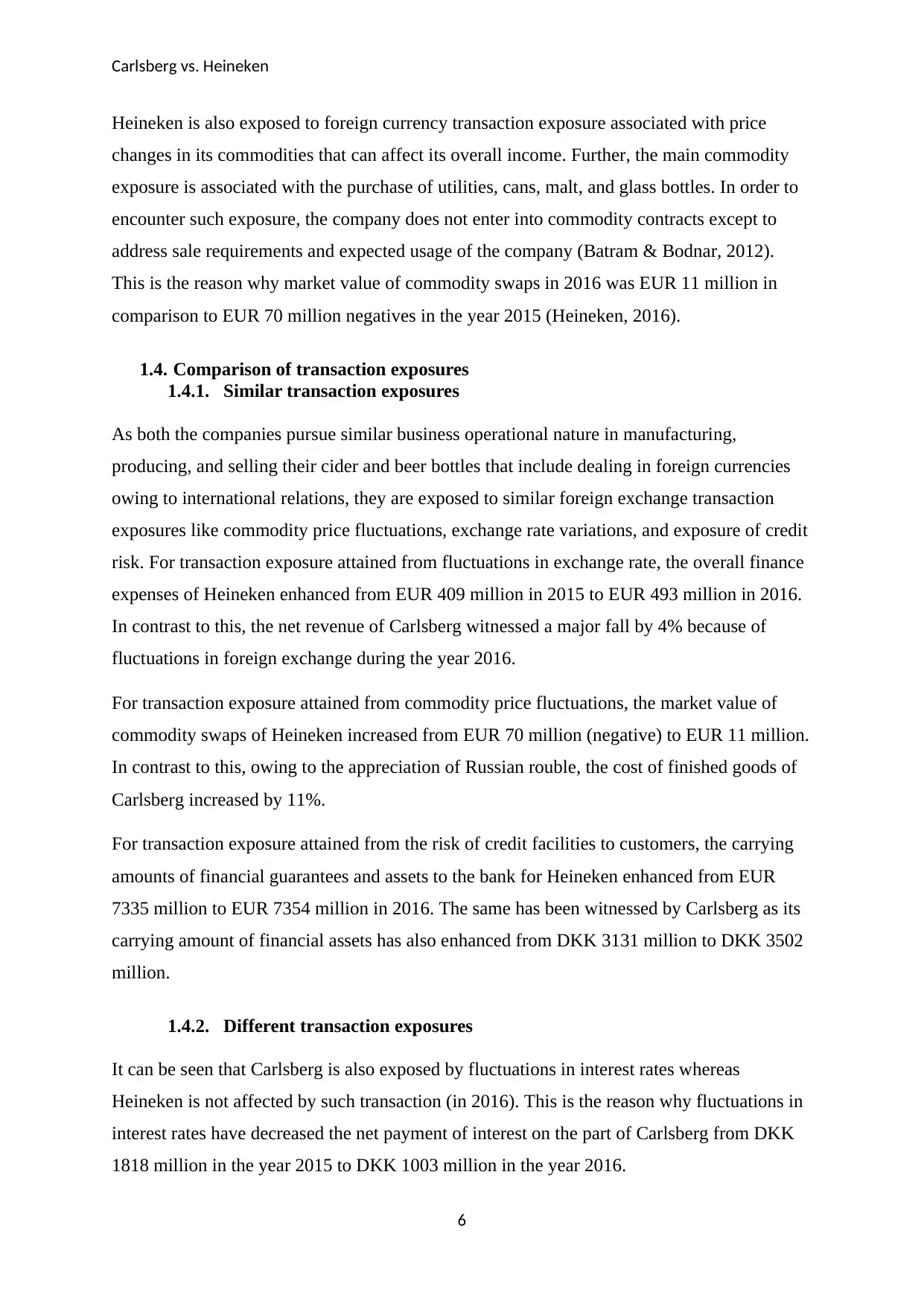
Carlsberg vs. Heineken
Heineken is also exposed to foreign currency transaction exposure associated with price
changes in its commodities that can affect its overall income. Further, the main commodity
exposure is associated with the purchase of utilities, cans, malt, and glass bottles. In order to
encounter such exposure, the company does not enter into commodity contracts except to
address sale requirements and expected usage of the company (Batram & Bodnar, 2012).
This is the reason why market value of commodity swaps in 2016 was EUR 11 million in
comparison to EUR 70 million negatives in the year 2015 (Heineken, 2016).
1.4. Comparison of transaction exposures
1.4.1. Similar transaction exposures
As both the companies pursue similar business operational nature in manufacturing,
producing, and selling their cider and beer bottles that include dealing in foreign currencies
owing to international relations, they are exposed to similar foreign exchange transaction
exposures like commodity price fluctuations, exchange rate variations, and exposure of credit
risk. For transaction exposure attained from fluctuations in exchange rate, the overall finance
expenses of Heineken enhanced from EUR 409 million in 2015 to EUR 493 million in 2016.
In contrast to this, the net revenue of Carlsberg witnessed a major fall by 4% because of
fluctuations in foreign exchange during the year 2016.
For transaction exposure attained from commodity price fluctuations, the market value of
commodity swaps of Heineken increased from EUR 70 million (negative) to EUR 11 million.
In contrast to this, owing to the appreciation of Russian rouble, the cost of finished goods of
Carlsberg increased by 11%.
For transaction exposure attained from the risk of credit facilities to customers, the carrying
amounts of financial guarantees and assets to the bank for Heineken enhanced from EUR
7335 million to EUR 7354 million in 2016. The same has been witnessed by Carlsberg as its
carrying amount of financial assets has also enhanced from DKK 3131 million to DKK 3502
million.
1.4.2. Different transaction exposures
It can be seen that Carlsberg is also exposed by fluctuations in interest rates whereas
Heineken is not affected by such transaction (in 2016). This is the reason why fluctuations in
interest rates have decreased the net payment of interest on the part of Carlsberg from DKK
1818 million in the year 2015 to DKK 1003 million in the year 2016.
6
Heineken is also exposed to foreign currency transaction exposure associated with price
changes in its commodities that can affect its overall income. Further, the main commodity
exposure is associated with the purchase of utilities, cans, malt, and glass bottles. In order to
encounter such exposure, the company does not enter into commodity contracts except to
address sale requirements and expected usage of the company (Batram & Bodnar, 2012).
This is the reason why market value of commodity swaps in 2016 was EUR 11 million in
comparison to EUR 70 million negatives in the year 2015 (Heineken, 2016).
1.4. Comparison of transaction exposures
1.4.1. Similar transaction exposures
As both the companies pursue similar business operational nature in manufacturing,
producing, and selling their cider and beer bottles that include dealing in foreign currencies
owing to international relations, they are exposed to similar foreign exchange transaction
exposures like commodity price fluctuations, exchange rate variations, and exposure of credit
risk. For transaction exposure attained from fluctuations in exchange rate, the overall finance
expenses of Heineken enhanced from EUR 409 million in 2015 to EUR 493 million in 2016.
In contrast to this, the net revenue of Carlsberg witnessed a major fall by 4% because of
fluctuations in foreign exchange during the year 2016.
For transaction exposure attained from commodity price fluctuations, the market value of
commodity swaps of Heineken increased from EUR 70 million (negative) to EUR 11 million.
In contrast to this, owing to the appreciation of Russian rouble, the cost of finished goods of
Carlsberg increased by 11%.
For transaction exposure attained from the risk of credit facilities to customers, the carrying
amounts of financial guarantees and assets to the bank for Heineken enhanced from EUR
7335 million to EUR 7354 million in 2016. The same has been witnessed by Carlsberg as its
carrying amount of financial assets has also enhanced from DKK 3131 million to DKK 3502
million.
1.4.2. Different transaction exposures
It can be seen that Carlsberg is also exposed by fluctuations in interest rates whereas
Heineken is not affected by such transaction (in 2016). This is the reason why fluctuations in
interest rates have decreased the net payment of interest on the part of Carlsberg from DKK
1818 million in the year 2015 to DKK 1003 million in the year 2016.
6
⊘ This is a preview!⊘
Do you want full access?
Subscribe today to unlock all pages.

Trusted by 1+ million students worldwide

Carlsberg vs. Heineken
2.0. Tools for managing transaction exposures
2.1. Carlsberg
In order to hedge foreign exposures, Carlsberg makes way to enter into forwarding exchange
contracts or net investment hedges.
2.2. Foreign exchange contracts
Since the Group holds various types of investments in foreign subsidiaries, it is clearly
exposed to foreign exchange risks. Foreign exchange contracts are entered by the company to
hedge such exposures. This is applicable to investments in CHF, CNY, RUB, and MYR.
Further, the basis for hedging in such contracts is reviewed at least once in a year and the
general parameters like cost and risk reduction are balanced (Ross, 2010). Nonetheless, in
economic terms, possessing debt in foreign currency through forwarding exchange contracts
assists the Group in hedging the future cash flow value of DKK that arise from particular
transactions or operating affairs (Moffett et. al, 2009).
Where the fair value adjustment of such forward exchange contracts cannot surpass the fair
value of the investment, adjustments of financial instruments are identified in other
comprehensive income; otherwise, these are identified in the income statement (John, 2011).
2.3. Heineken
In order to hedge foreign exposures, the company uses derivatives in their ordinary course of
business. Basically, the company implements hedge accounting to reduce the impact of
transaction exposure in its income statement (Christie, 2014).
2.4. Cross-currency interest rate swap
In the year 2016, Heineken has entered into various cross-currency interest rate swaps that
have been reflected as cash flow hedges to hedge the risk of foreign exchange rates on the
principal value and future interest payments of its borrowings in US dollars (Fun & Resnick,
2011).
2.5. Commodity Swaps
7
2.0. Tools for managing transaction exposures
2.1. Carlsberg
In order to hedge foreign exposures, Carlsberg makes way to enter into forwarding exchange
contracts or net investment hedges.
2.2. Foreign exchange contracts
Since the Group holds various types of investments in foreign subsidiaries, it is clearly
exposed to foreign exchange risks. Foreign exchange contracts are entered by the company to
hedge such exposures. This is applicable to investments in CHF, CNY, RUB, and MYR.
Further, the basis for hedging in such contracts is reviewed at least once in a year and the
general parameters like cost and risk reduction are balanced (Ross, 2010). Nonetheless, in
economic terms, possessing debt in foreign currency through forwarding exchange contracts
assists the Group in hedging the future cash flow value of DKK that arise from particular
transactions or operating affairs (Moffett et. al, 2009).
Where the fair value adjustment of such forward exchange contracts cannot surpass the fair
value of the investment, adjustments of financial instruments are identified in other
comprehensive income; otherwise, these are identified in the income statement (John, 2011).
2.3. Heineken
In order to hedge foreign exposures, the company uses derivatives in their ordinary course of
business. Basically, the company implements hedge accounting to reduce the impact of
transaction exposure in its income statement (Christie, 2014).
2.4. Cross-currency interest rate swap
In the year 2016, Heineken has entered into various cross-currency interest rate swaps that
have been reflected as cash flow hedges to hedge the risk of foreign exchange rates on the
principal value and future interest payments of its borrowings in US dollars (Fun & Resnick,
2011).
2.5. Commodity Swaps
7
Paraphrase This Document
Need a fresh take? Get an instant paraphrase of this document with our AI Paraphraser
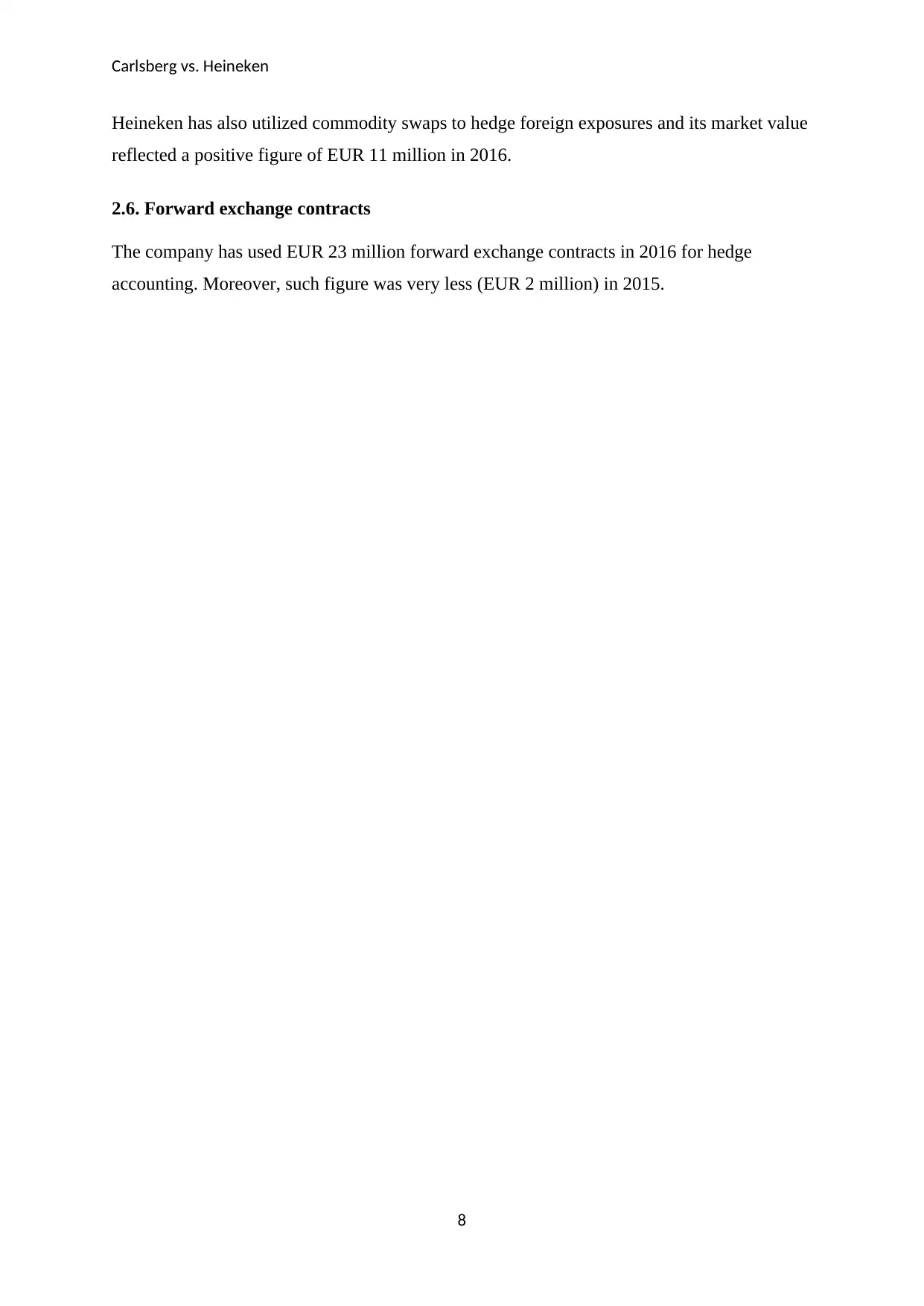
Carlsberg vs. Heineken
Heineken has also utilized commodity swaps to hedge foreign exposures and its market value
reflected a positive figure of EUR 11 million in 2016.
2.6. Forward exchange contracts
The company has used EUR 23 million forward exchange contracts in 2016 for hedge
accounting. Moreover, such figure was very less (EUR 2 million) in 2015.
8
Heineken has also utilized commodity swaps to hedge foreign exposures and its market value
reflected a positive figure of EUR 11 million in 2016.
2.6. Forward exchange contracts
The company has used EUR 23 million forward exchange contracts in 2016 for hedge
accounting. Moreover, such figure was very less (EUR 2 million) in 2015.
8
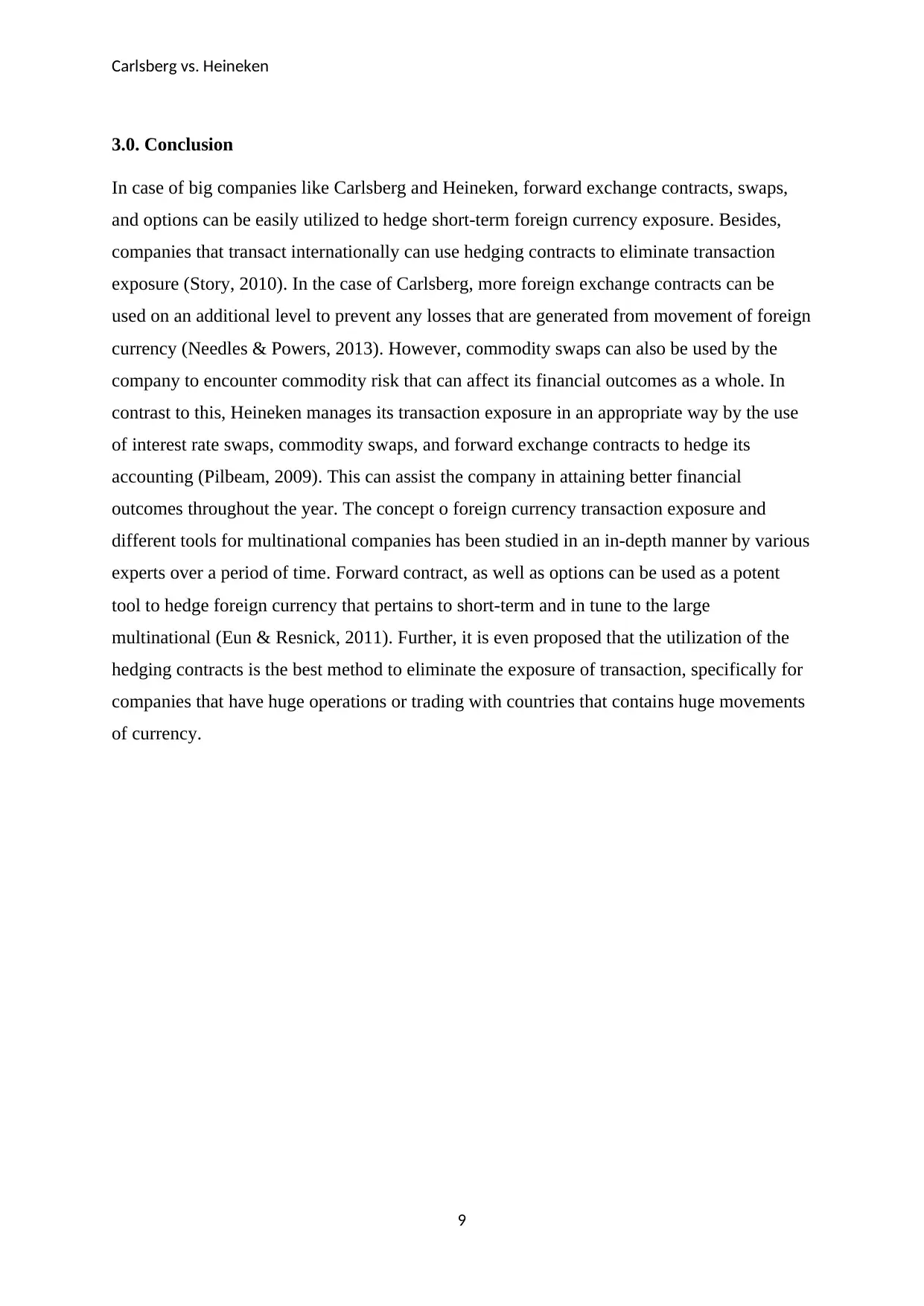
Carlsberg vs. Heineken
3.0. Conclusion
In case of big companies like Carlsberg and Heineken, forward exchange contracts, swaps,
and options can be easily utilized to hedge short-term foreign currency exposure. Besides,
companies that transact internationally can use hedging contracts to eliminate transaction
exposure (Story, 2010). In the case of Carlsberg, more foreign exchange contracts can be
used on an additional level to prevent any losses that are generated from movement of foreign
currency (Needles & Powers, 2013). However, commodity swaps can also be used by the
company to encounter commodity risk that can affect its financial outcomes as a whole. In
contrast to this, Heineken manages its transaction exposure in an appropriate way by the use
of interest rate swaps, commodity swaps, and forward exchange contracts to hedge its
accounting (Pilbeam, 2009). This can assist the company in attaining better financial
outcomes throughout the year. The concept o foreign currency transaction exposure and
different tools for multinational companies has been studied in an in-depth manner by various
experts over a period of time. Forward contract, as well as options can be used as a potent
tool to hedge foreign currency that pertains to short-term and in tune to the large
multinational (Eun & Resnick, 2011). Further, it is even proposed that the utilization of the
hedging contracts is the best method to eliminate the exposure of transaction, specifically for
companies that have huge operations or trading with countries that contains huge movements
of currency.
9
3.0. Conclusion
In case of big companies like Carlsberg and Heineken, forward exchange contracts, swaps,
and options can be easily utilized to hedge short-term foreign currency exposure. Besides,
companies that transact internationally can use hedging contracts to eliminate transaction
exposure (Story, 2010). In the case of Carlsberg, more foreign exchange contracts can be
used on an additional level to prevent any losses that are generated from movement of foreign
currency (Needles & Powers, 2013). However, commodity swaps can also be used by the
company to encounter commodity risk that can affect its financial outcomes as a whole. In
contrast to this, Heineken manages its transaction exposure in an appropriate way by the use
of interest rate swaps, commodity swaps, and forward exchange contracts to hedge its
accounting (Pilbeam, 2009). This can assist the company in attaining better financial
outcomes throughout the year. The concept o foreign currency transaction exposure and
different tools for multinational companies has been studied in an in-depth manner by various
experts over a period of time. Forward contract, as well as options can be used as a potent
tool to hedge foreign currency that pertains to short-term and in tune to the large
multinational (Eun & Resnick, 2011). Further, it is even proposed that the utilization of the
hedging contracts is the best method to eliminate the exposure of transaction, specifically for
companies that have huge operations or trading with countries that contains huge movements
of currency.
9
⊘ This is a preview!⊘
Do you want full access?
Subscribe today to unlock all pages.

Trusted by 1+ million students worldwide
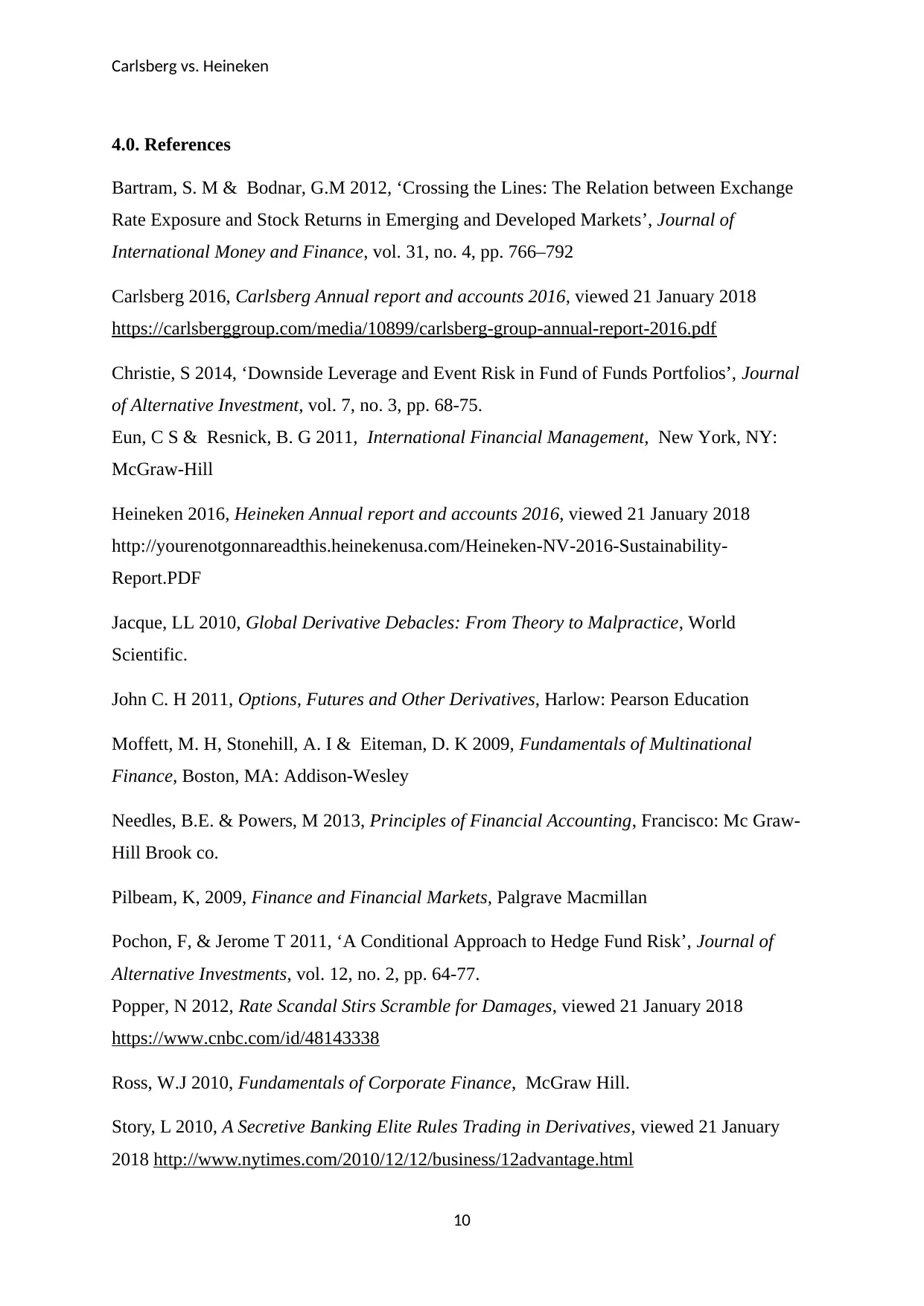
Carlsberg vs. Heineken
4.0. References
Bartram, S. M & Bodnar, G.M 2012, ‘Crossing the Lines: The Relation between Exchange
Rate Exposure and Stock Returns in Emerging and Developed Markets’, Journal of
International Money and Finance, vol. 31, no. 4, pp. 766–792
Carlsberg 2016, Carlsberg Annual report and accounts 2016, viewed 21 January 2018
https://carlsberggroup.com/media/10899/carlsberg-group-annual-report-2016.pdf
Christie, S 2014, ‘Downside Leverage and Event Risk in Fund of Funds Portfolios’, Journal
of Alternative Investment, vol. 7, no. 3, pp. 68-75.
Eun, C S & Resnick, B. G 2011, International Financial Management, New York, NY:
McGraw-Hill
Heineken 2016, Heineken Annual report and accounts 2016, viewed 21 January 2018
http://yourenotgonnareadthis.heinekenusa.com/Heineken-NV-2016-Sustainability-
Report.PDF
Jacque, LL 2010, Global Derivative Debacles: From Theory to Malpractice, World
Scientific.
John C. H 2011, Options, Futures and Other Derivatives, Harlow: Pearson Education
Moffett, M. H, Stonehill, A. I & Eiteman, D. K 2009, Fundamentals of Multinational
Finance, Boston, MA: Addison-Wesley
Needles, B.E. & Powers, M 2013, Principles of Financial Accounting, Francisco: Mc Graw-
Hill Brook co.
Pilbeam, K, 2009, Finance and Financial Markets, Palgrave Macmillan
Pochon, F, & Jerome T 2011, ‘A Conditional Approach to Hedge Fund Risk’, Journal of
Alternative Investments, vol. 12, no. 2, pp. 64-77.
Popper, N 2012, Rate Scandal Stirs Scramble for Damages, viewed 21 January 2018
https://www.cnbc.com/id/48143338
Ross, W.J 2010, Fundamentals of Corporate Finance, McGraw Hill.
Story, L 2010, A Secretive Banking Elite Rules Trading in Derivatives, viewed 21 January
2018 http://www.nytimes.com/2010/12/12/business/12advantage.html
10
4.0. References
Bartram, S. M & Bodnar, G.M 2012, ‘Crossing the Lines: The Relation between Exchange
Rate Exposure and Stock Returns in Emerging and Developed Markets’, Journal of
International Money and Finance, vol. 31, no. 4, pp. 766–792
Carlsberg 2016, Carlsberg Annual report and accounts 2016, viewed 21 January 2018
https://carlsberggroup.com/media/10899/carlsberg-group-annual-report-2016.pdf
Christie, S 2014, ‘Downside Leverage and Event Risk in Fund of Funds Portfolios’, Journal
of Alternative Investment, vol. 7, no. 3, pp. 68-75.
Eun, C S & Resnick, B. G 2011, International Financial Management, New York, NY:
McGraw-Hill
Heineken 2016, Heineken Annual report and accounts 2016, viewed 21 January 2018
http://yourenotgonnareadthis.heinekenusa.com/Heineken-NV-2016-Sustainability-
Report.PDF
Jacque, LL 2010, Global Derivative Debacles: From Theory to Malpractice, World
Scientific.
John C. H 2011, Options, Futures and Other Derivatives, Harlow: Pearson Education
Moffett, M. H, Stonehill, A. I & Eiteman, D. K 2009, Fundamentals of Multinational
Finance, Boston, MA: Addison-Wesley
Needles, B.E. & Powers, M 2013, Principles of Financial Accounting, Francisco: Mc Graw-
Hill Brook co.
Pilbeam, K, 2009, Finance and Financial Markets, Palgrave Macmillan
Pochon, F, & Jerome T 2011, ‘A Conditional Approach to Hedge Fund Risk’, Journal of
Alternative Investments, vol. 12, no. 2, pp. 64-77.
Popper, N 2012, Rate Scandal Stirs Scramble for Damages, viewed 21 January 2018
https://www.cnbc.com/id/48143338
Ross, W.J 2010, Fundamentals of Corporate Finance, McGraw Hill.
Story, L 2010, A Secretive Banking Elite Rules Trading in Derivatives, viewed 21 January
2018 http://www.nytimes.com/2010/12/12/business/12advantage.html
10
1 out of 10
Related Documents
Your All-in-One AI-Powered Toolkit for Academic Success.
+13062052269
info@desklib.com
Available 24*7 on WhatsApp / Email
![[object Object]](/_next/static/media/star-bottom.7253800d.svg)
Unlock your academic potential
Copyright © 2020–2025 A2Z Services. All Rights Reserved. Developed and managed by ZUCOL.





